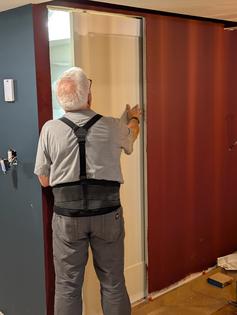Ask the Builder: Pocket doors are amazing
I installed a pocket door in my son’s basement several days ago. The basement remodeling project has stretched out over a year because we can only work together on Saturdays and on occasional days he can take off from work. It was a unique pleasure to show him how simple it is to install a door that disappears into a wall.
He remembered the pocket door we had at the last house I built for my family. He and I would play railroad crossing when he was a toddler. I would close the door slowly as he approached it on his tiny rolling horse toy. When the imaginary train had passed by, I’d open the door, allowing him to travel back to the laundry room. Such fun memories!
Pocket doors are sleek, and they save lots of space. Traditional hinged doors that swing take up lots of room. You can’t have the swinging door bump into things when it needs to be fully open. A pocket door just tucks itself away into the void space between two finished wall surfaces.
I grew up in Cincinnati. There were thousands of stately Victorian homes in the suburbs Clifton, Hyde Park, East Walnut Hills and Mt. Lookout that had double pocket doors between rooms. Most of these homes were built in the late 1800s or early 1900s. Architects of old used double pocket doors to create both privacy and version 1.0 of the open-concept floor plan.
These ancient pocket doors were heavy and hard to pull out of the pockets, and they often jumped off the tracks. It didn’t take long for these to fall out of favor with homeowners. New pocket door hardware is available that solves all these problems.
The first custom home I built had two pocket doors, one in a half-bathroom and the other in the laundry room. The architect specified an inferior pocket door frame made from thin wood. These slats had a tendency to warp over time. The warped slats would rub against the door as it opened and closed.
I switched to a pocket door frame system that used thin wood wall studs wrapped in metal. These vertical studs were straight as an arrow, and the metal covering ensures the studs never warp. This same manufacturer also solved the problem of the doors jumping off the upper horizontal track.
The door is suspended from the frame by two trolleys. Each trolley had three wheels instead of the two-wheeled trolleys on the inferior frames. The track above the door had two parallel channels that the trolleys nested in. It was impossible for the door to jump off the track.
I used that same frame in my son’s basement. The frame takes only minutes to install, as long as you follow the instructions for creating the overall rough opening. The manufacturer creates all the components, so they don’t have to be cut. It’s a dream to install the rough pocket door frame.
You can watch a video of me installing this frame at the Ask the Builder website. Go here: http://go.askthebuilder.com/sc1500
The frame and system I used at my son’s home has delightful soft-close hardware. You probably have this in your kitchen or bathroom cabinets. As you close a drawer, the hardware takes over and magically pulls the drawer into the cabinet. There’s no banging noise or pinched fingers.
Moderate carpentry skills are required to trim out a pocket door. The jambs that hide the pocket must be cut to a width of 1 1/4 inches. The vertical jambs are applied first, and the ones for the top of the door are installed last. These jambs should be installed with decorative small-head trim screws. Using screws allows you to remove the jambs in minutes if you need to replace the door or retrieve something that found its way into the pocket.
Locking pocket door handles are available if you desire to install one for a bathroom or other room where you need privacy. You should have no issues locating the finish to match all the other hardware in your home.
You can mount two modern pocket door frames facing each other to create the look of the old Victorian homes. The pocket door frame doesn’t discriminate. You can install any normal-width door of any style in the frame. Heavy, solid doors that weigh up to 400 pounds can be supported using a special pocket door hardware kit.
My son’s home is only four years old. His builder made a terrible mistake by not using a pocket door for his small laundry room. This room is off the kitchen and has an inswing door into the tiny room. A pocket door would have made perfect sense in this situation. I’m sure you have pesky swinging doors in your home that you wish were pocket doors, don’t you?
Subscribe to Tim’s FREE newsletter at AsktheBuilder.com. Tim offers phone coaching calls if you get stuck during a DIY job. Go here: go.askthebuilder.com/coaching
©2025 Tim Carter. Distributed by Tribune Content Agency, LLC.






























Comments